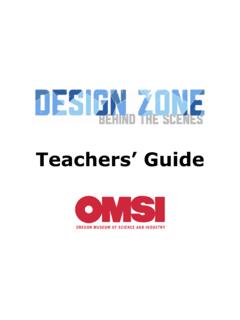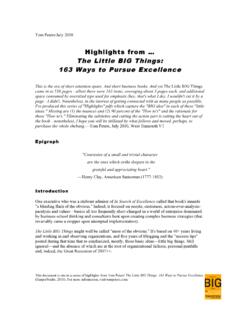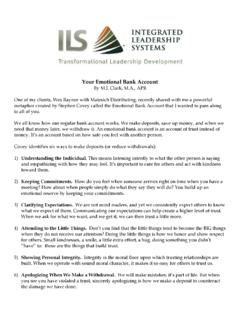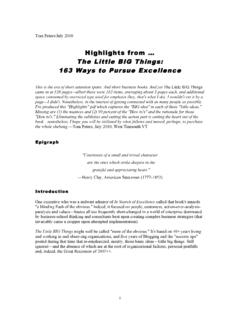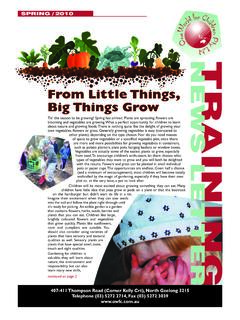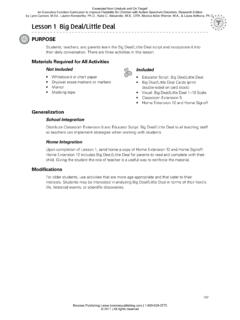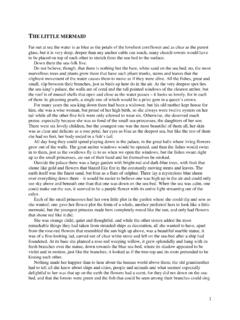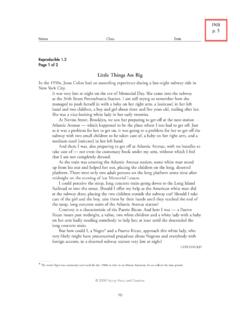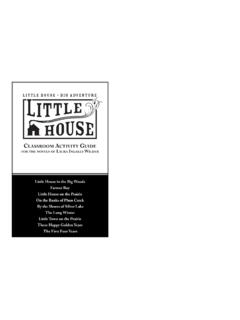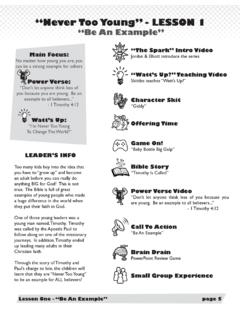Transcription of Big Things Come in Little Packages - OMSI
1 Big Things come in Little Packages A - 1 Chemistry in the K 8 Classroom Grades K 5 2007, OMSI Big Things come in Little Packages Learning Objectives: Objects that are the same volume but different weights have different densities. SNEAK PEAK inside .. Advance Preparation Set Up Activity Clean Up 15 minutes 0 minutes 20 minutes 2 minutes GRADE LEVEL K 5 SCIENCE TOPICS Physical Properties Techniques PROCESS SKILLS Comparing and Contrasting Measuring Organizing Data Evaluating GROUP SIZE 1 2 TIME REQUIRED ACTIVITY Students learn about density by comparing gift-wrapped Packages that are the same size but have different densities.
2 STUDENT SUPPLIES small boxes, all same size coins, nails, screws, bolts, or other heavy metal scraps wood blocks or scraps foam rubber, Styrofoam peanuts, or large marshmallows gift wrapping paper ADVANCE PREPARATION Fill boxes with different materials and wrap. OPTIONAL EXTRAS EXTENSIONS Twenty Questions (p. A - 6) Determining Volume (p. A - 6) Determining Density (p. A - 7) Big Things come in Little Packages A - 2 Chemistry in the K 8 Classroom Grades K 5 2007, OMSI Item Amount Needed small boxes of the same size (approx.)
3 4-inch cubes) 3 per class coins, nails, screws, bolts, or other heavy metal scraps enough to fill box wooden block or scraps of wood enough to fill box foam rubber, Styrofoam peanuts, or large marshmallows enough to fill box gift wrapping paper and tape enough to cover each box For Extension or Demonstration supplies, see the corresponding section. Supplies Preparation Boxes: Make sure that all three boxes are the same size and shape. (A cut-down half-gallon milk carton works well as a box.
4 Fill one box as full as possible with heavy metal scraps, nuts, bolts, screws, etc. Fill a second box as full as possible with a block of wood or scraps of wood. Fill the third box (without making the box bulge) with foam rubber, Styrofoam peanuts, or large marshmallows. Gift wrap the three boxes. You can wrap the three boxes identically or wrap them differently so that the students will have an additional criterion for comparing the three boxes. none ADVANCE PREPARATION SUPPLIES SETUP Big Things come in Little Packages A - 3 Chemistry in the K 8 Classroom Grades K 5 2007, OMSI In this acitivity, students will have the opportunity to compare gift-wrapped Packages that are the same size but different densities.
5 Have the class look at (but not touch!) the three gift-wrapped boxes. By not allowing the students to touch or feel the boxes, you will limit the information they can gather and also increase their curiosity. Atoms and molecules are also impossible to touch and feel directly, yet scientists are still curious about them. Scientists use the properties of materials to learn about the atoms and molecules inside them. What is alike about the Packages ? They are the same size or volume, they take up the same amount of space, they are all boxes, and they are all wrapped as gifts.
6 What might be different about the Packages ? They could be different weights, different values, filled to a different degree, etc. It s hard to tell by just looking. Without having the students lift or touch the boxes, ask: Which box do you think is heaviest? You can make a bar graph of student responses: Column one = number of students who think box 1 is heaviest. Column two = number of students who think box 2 is heaviest. Column three = number of students who think box 3 is heaviest.
7 Column four = number of students who think all boxes weigh the same. Have the students hypothesize what is in the Packages . This will not be a very informed hypothesis because they have very Little information. The only clue they have is package size. INTRODUCING THE ACTIVITY Let the students speculate before offering answers to any questions. The answers at right are provided for the teacher. Choose questions that are appropriate for your classroom. Big Things come in Little Packages A - 4 Chemistry in the K 8 Classroom Grades K 5 2007, OMSI This activity does not have a Scientific Procedure.
8 Instead, lead the activity according to the directions below. NOTES One of the best ways to find out what s inside the box is to measure as many Things as possible about the box, such as the weight, size, shape, color, etc. Here is a fun way to demonstrate the different weights of the boxes to the class. 1. Have three volunteers come forward (preferably including one very small student and one very large and apparently strong student). 2. Give the lightest weight package (the foam or marshmallows) to the smallest volunteer.
9 Give the heaviest package (metal) to a strong volunteer. 3. Ask the three students to do arm lifts with their package. If the Packages are on the small side, the students may need to extend their arms to experience the weight difference as they do arm lifts. 4. Ask the class to count the number of arm lifts each student can do with the package over a period of time (about 1 minute). Compare the number of arm lifts for each package. 5. Ask the volunteers how difficult the task was. Compare their answers.
10 6. Ask the class: What might be different about the Packages ? Which box is heaviest? (You can make another bar graph of student responses.) Ask the class: Who changed their minds about which package is heaviest? On what did you base your decision? 7. If it is still not clear which package is heaviest, give several (or all) students the opportunity to lift each of the Packages and compare. 8. Have students hypothesize again what is in the various Packages . They have more information, or data, now. When scientists make a hypothesis, they base it on all the information they have.


